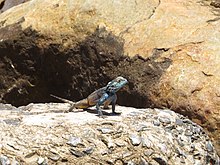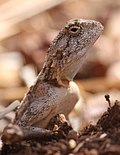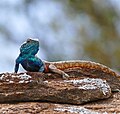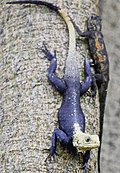Agama (lizard)
| Agama | |
|---|---|

| |
| Agama agama | |
| Scientific classification | |
| Kingdom: | Animalia |
| Phylum: | Chordata |
| Class: | Reptilia |
| Order: | Squamata |
| Suborder: | Iguania |
| Family: | Agamidae |
| Subfamily: | Agaminae |
| Genus: | Agama Daudin, 1802 |
| Type species | |
| Lacerta agama Linnaeus, 1758
| |
| Species | |
|
See text | |


Agama (from Sranan Tongo meaning "lizard") is a genus of small-to-moderate-sized, long-tailed, insectivorous Old World lizards. The genus Agama includes at least 37 species in Africa, especially sub-Saharan Africa, where most regions are home to at least one species. Eurasian agamids are largely assigned to genus Laudakia. The various species differ in size, ranging from about 12 to 30 centimetres (5 to 12 in) in length, when fully grown.
Their colour also differs between species, between genders, and according to mood; for example, a dominant male in display mode is far brighter than when it has been caught, beaten by another male, or otherwise alarmed. Females tend to be less colourful than the males of the species.
According to species, agamas live in forest, in bush, among rocks and on crags, but where their habitat has been cleared, or simply occupied by humans, some species also adapt to life in villages and compounds, for example inside the thatch of huts and other sheltering crevices. Agamids' hind legs generally are long and powerful; and the lizards can run and leap swiftly when alarmed.[1]
Agamas are diurnal, active during the day. They can tolerate higher temperatures than most reptiles, but when temperatures approach 38 °C (100 °F) they generally shelter in the shade. Males frequently threaten each other by nodding, weaving, and displaying their brightest colours to establish dominance. If that is insufficient, they lash their tails and threaten each other with open jaws. The jaws are very powerful, and older males commonly have damaged tails as souvenirs of past combat. Females may sometimes chase and fight one another, and hatchlings mimic the adults' behaviour.[1]
Agamas are mainly insectivorous, hunting prey by sight and snatching it opportunistically. Their incisor-like front teeth and powerful jaws are adapted to dealing with quite large, hard prey. They also may eat eggs of other lizards, and sometimes feed on vegetable matter, such as suitable grass, berries, and seeds.
Though not formally polygamous, dominant males commonly accommodate several females at a time in their territory. During courtship, and also when asserting his territory, the male bobs his head in display; this gives rise to some of the common names, such as Afrikaans koggelmander (literally, "little mocking man"). Females occasionally initiate courtship by offering their hindquarters to the male and provoking him to catch her. Typically the breeding season is timed for eggs to be laid during the season after the rains. Eggs are laid in clutches of up to 12, depending on species and the size of the female.[1]
Etymology and taxonomy[]
In the 10th edition of Systema Naturae of 1758, [2] Linnaeus used the name Agama (pg. 288) as the species Lacerta Agama (with Agama originally capitalized to indicate a name in apposition rather than a Latin adjective, which he would have made lowercase). His own earlier description from 1749 [3] was derived from Seba, [4] who described and illustrated a number of lizards as Salamandra amphibia and Salamandra Americana, said to resemble in some ways a chameleon lizard and that supposedly came (in error) from "America." Seba did not use the term "agama", however. Linnaeus repeated Seba's error in stating that the lizards lived in the Americas ["habitat in America"], and he included other types of lizards shown and mentioned by Seba under his species name Agama.
Daudin [5] later created the new genus, Agama, to incorporate various African and Asian lizards, as well as species from Mexico, the Caribbean, Central America, and South America. He noted that the name agama was used by inhabitants of Guiana for a species that he included in the genus Agama.
The word "agama" [6] has been traced to West African Gbe languages as a name for the chameleon. The word was brought to Dutch Guiana (modern Suriname) by imported West African slaves and was then used in local creole languages for types of local lizards.[7] Linnaeus may have taken the name "agama" from some unidentified source in the mistaken belief that the reptiles came from the Americas as indicated by Seba.
The name "agama" has no connection to either Greek agamos "unmarried" (as a supposed Latin feminine agama) or to Greek agamai "wonder" as sometimes suggested.
Because of the confusion over the actual taxon that was the basis for the name Agama agama, Wagner, et al. (2009) [8] designated a neotype (ZFMK 15222), using a previously described specimen from Cameroon in the collection of the Zoologisches Forschungsmuseum Alexander Koenig in Bonn.
Species[]
Listed alphabetically.[9]
| Image | Scientific name | Common name | Distribution |
|---|---|---|---|
 |
Agama aculeata Merrem, 1820 | ground agama | Namibia, Botswana, Zimbabwe, Republic of South Africa, Mozambique, S Angola, Tanzania, Zambia, Eswatini |
 |
Agama africana (Hallowell, 1844) | West African Rainbow Lizard | Liberia, Ivory Coast, Sierra Leone ?, Guinea |
 |
Agama agama (Linnaeus, 1758) | red-headed rock agama, common agama, rainbow agama | Benin, Burkina Faso, Cameroon, Cape Verde Islands, Chad, Gabon, Ghana, Guinea, Guinea Bissau, Kenya, Liberia, Mali, Mauritania, Nigeria, Senegal, Togo, and Madagascar |
 |
Agama anchietae Bocage, 1896 | western rock agama, Anchieta's agama | S Congo (Brazzaville), Angola, Namibia, Republic of South Africa (NW Cape), Botswana |
 |
Agama armata W. Peters, 1855 | tropical spiny agama | South Africa, Mozambique, Namibia, Botswana, Zambia, Swaziland, southern Democratic Republic of the Congo (Zaire), southwestern Kenya, and central Tanzania |
 |
Agama atra Daudin, 1802 | southern rock agama | Southern Africa |
| Agama bocourti Rochebrune, 1884 | Bocourt's agama | Senegal, Gambia | |
| Agama boensis Monard, 1940 | Guinea-Bissau, Guinea, Mali, Senegal | ||
 |
Agama bottegi Boulenger, 1897 | Somali agama | Mali; Mauritania; Niger; Senegal |
| Agama boueti Chabanaud, 1917 | Mali agama | Mali; Mauritania; Niger; Senegal | |
| Agama boulengeri Lataste, 1886 | Boulenger's agama | Mali, Mauritania | |
| Agama caudospinosa Meek, 1910 | Elmenteita rock agama | Kenya | |
| Agama cristata Mocquard, 1905 | insular agama | Guinea (Conakry), Mali | |
| Agama doriae Boulenger, 1885 | Nigeria agama | Ghana, Togo, Nigeria, Central African Republic to Eritrea and Ethiopia, N Cameroon, Sudan | |
| Agama etoshae , 1981 | Etosha agama | Namibia | |
| Agama finchi Böhme, , , Lötters & Köhler, 2005 | Finch's agama or Malaba rock agama | W Kenya, Ethiopia | |
 |
Agama gracilimembris Chabanaud, 1918 | Benin agama | Ghana, Benin, Nigeria, Cameroon, Central African Republic, probably in Chad (L. Chirio, pers. comm.), Mali, Guinea (Conakry), Burkina Faso |
 |
Agama hartmanni W. Peters, 1869 | agama[10] | |
 |
Agama hispida (Kaup, 1827) | common spiny agama | Republic of South Africa, Zimbabwe, Namibia, S Angola, Botswana, Mozambique, Malawi |
 |
Agama impalearis Boettger, 1874 | Bibron's agama | Morocco but it extends south to Western Sahara and east into eastern Algeria |
| Agama insularis Chabanaud, 1918 | insular agama | Rooma Island, Guinea | |
| Agama kaimosae Loveridge, 1935 | Kakamega agama | Kenya | |
 |
Agama kirkii Boulenger, 1885 | Kirk's rock agama | Malawi, Zambia, Zimbabwe, Mozambique, E Botswana, SW Tanzania |
| Agama knobeli Boulenger & Power, 1921 | southern rock agama | Namibia | |
| Agama lanzai Wagner, , & Böhme, 2013 | Somalia | ||
 |
Agama lebretoni Wagner, & Schmitz, 2009 | Lebreton's agama | Cameroon, Equatorial Guinea, Gabon, Fernando Poo (Bioko Island), Nigeria |
 |
Agama lionotus Boulenger, 1896 | Kenyan rock agama | Tanzania, Uganda, Kenya, Ethiopia |
| Agama lucyae Wagner & Bauer, 2011 | N Ethiopia | ||
| Agama montana Barbour & Loveridge, 1928 | montane rock agama | Tanzania | |
| Agama mossambica W. Peters, 1854 | Mozambique agama | Tanzania, Malawi, Zambia, Mozambique, E Zimbabwe | |
| Agama mucosoensis Hellmich, 1957 | Mucoso agama | Angola (Mucoso, Dondo, and Libolo/Luati) | |
 |
Agama mwanzae Loveridge, 1923 | Mwanza flat-headed rock agama | Tanzania, Rwanda, Kenya |
| Agama parafricana , & , 2012 | Benin; Ghana; Togo | ||
| Agama paragama , 1968 | false agama | N Nigeria, N Cameroon, Mali, Central African Republic, Ghana, Burkina Faso, Benin, probably in W Chad (L. Chirio, pers. comm.), Niger | |
| Agama persimilis Parker, 1942 | painted agama, similar agama | Somalia, Ethiopia, E/NE Kenya | |
 |
Agama picticauda (Peters, 1877) | Peter’s rock agama[11][12] | Gabon |
 |
Agama planiceps W. Peters, 1862 | Namib rock agama | Namibia (Damaraland, Kaokoveld) |
| Agama robecchii Boulenger, 1892 | Robecchi's agama | N Somalia, E Ethiopia | |
 |
Agama rueppelli Vaillant, 1882 | Rüppell's agama, arboreal agama | Somalia, E Ethiopia, Kenya, S Sudan |
| Agama sankaranica Chabanaud, 1918 | Senegal agama | Guinea (Conakry), Nigeria, Ivory Coast, Ghana, Burkina Faso, Benin, Togo, Mali, Cameroon (?), Senegal, Niger | |
| Agama somalica Wagner, Leaché, Mazuch & Böhme, 2013 | NE Somalia | ||
| Agama spinosa Gray, 1831 | Gray’s agama, spiny agama | Egypt, Sudan, N Ethiopia, Eritrea, Djibouti, N Somalia | |
| Agama tassiliensis , Padial, and , 2011 | Mali (Adrar des Ifoghas), Niger (Aïr Mountains), Algeria (Ahaggar Mountains), Libya (Tassili n’Ajjer) | ||
| Agama turuensis Loveridge, 1932 | Tanzania | ||
| Agama wachirai Malonza, Spawls, Finch, & Bauer, 2021 | Marsabit rock agama | Kenya | |
 |
Agama weidholzi Wettstein, 1932 | Gambia agama | Senegal, Gambia, W Mali, Guinea-Bissau |
Nota bene: A binomial authority in parentheses indicates that the species was originally described in a genus other than Agama.
References[]
- ^ a b c Burton, Maurice; Burton, Robert (1974). The Funk & Wagnalls Wildlife Encyclopedia. 1. New York, N.Y.: Funk and Wagnalls. OCLC 20316938.
- ^ Linné, Carl von (1758). Systema naturae per regna tria naturae. 1 (10th ed.). p. 215 – via Biodiversity Heritage Library.
- ^ Linnaeus, C. (1749). Amoenitates academicæ seu dissertationes variæ physicæ, medicæ botanicæ antehac seorsim editæ nunc collectæ et auctæ cum tabulis æneis. Vol. 1, Holmiæ, Lipsiæ, 563 pp, tab. I–XVI
- ^ Seba, A. (1734). Locupletissimi rerum naturalium thesauri accurata descriptio. Vol. 1. (pg. 169). J. Wetstenium, & Guil. Smith, & Janssonio-Waesbergios, Amsterdam.
- ^ Daudin, F.M. (1802). Histoire Naturelle, Générale et Particulière des Reptiles; Ouvrage faisant suite à l'Histoire Naturelle générale et particulière, composée par Leclerc de Buffon; et rédigée par C.S. Sonnini, membre de plusieurs sociétés savantes. Tome troisième [Volume 3]. Paris: F. Dufart. 452 pp. (Agama, new genus, p. 333). (in French)
- ^ "agama". The American Heritage Dictionary of the English Language (5th ed.). Boston: Houghton Mifflin Harcourt.
- ^ Arends, Jacques (2017). Language and Slavery: A social and linguistic history of the Suriname creoles. John Benjamins Publishing Company.
- ^ Wagner, Philipp; Wilms, Thomas M.; Bauer, Aaron; Böhme, Wolfgang (2009). "Studies on African Agama. V. On the origin of Lacerta agama Linnaeus, 1758 (Squamata: Agamidae)" (PDF). Bonner zoologische Beiträge. 56: 215–223.
- ^ "Agama ". The Reptile Database. www.reptile-database.org. Retrieved 3 February 2014.
- ^ Beolens, Bo; Watkins, Michael; Grayson, Michael (2011). The Eponym Dictionary of Reptiles. Baltimore. Johns Hopkins University Press. xiii + 296 pp. ISBN 978-1-4214-0135-5. (Agama hartmanni, p. 117).
- ^ "Peters's rock agama, Agama picticauda Squamata: Agamidae". Invasive.Org. Retrieved 2020-12-13.
- ^ "Peters's Rock Agama (Agama picticauda)". iNaturalist. 2018-11-17. Retrieved 2020-12-13.
Further reading[]
- Daudin FM (1802). Histoire Naturelle, Générale et Particulière des Reptiles; Ouvrage faisant suite à l'Histoire Naturelle générale et particulière, composée par Leclerc de Buffon; et rédigée par C.S. Sonnini, membre de plusieurs sociétés savantes. Tome troisième [Volume 3]. Paris: F. Dufart. 452 pp. (Agama, new genus, p. 333). (in French).
- Manthey, Ulrich; Schuster, Norbert (1996). Agamid Lizards. U.S.A.: T.F.H Publications Inc. 189 pp. ISBN 978-0793801282.
- Spawls, Stephen; Howell, Kim M.; Drewes, Robert C. (2006). Reptiles and Amphibians of East Africa. Princeton, New Jersey: Princeton University Press. ISBN 978-0691128849.
External links[]
| Wikimedia Commons has media related to Agama. |
- Information on Agamids in captivity
- . New International Encyclopedia. 1905.
- Agama (genus)
- Agamid lizards of Africa
- Lizard genera
- Taxa named by François Marie Daudin